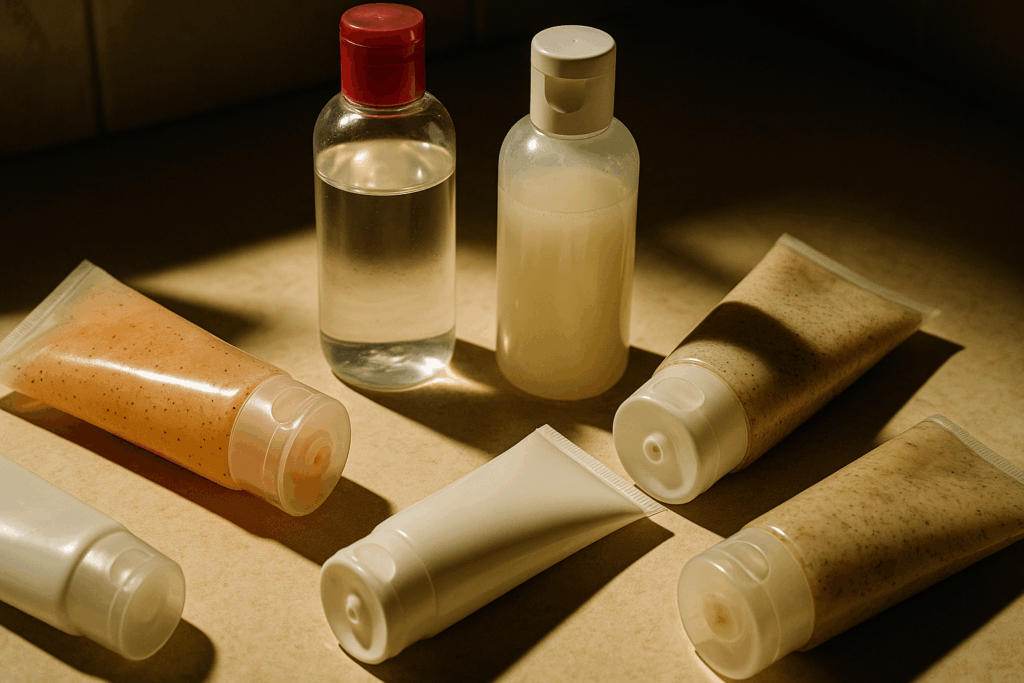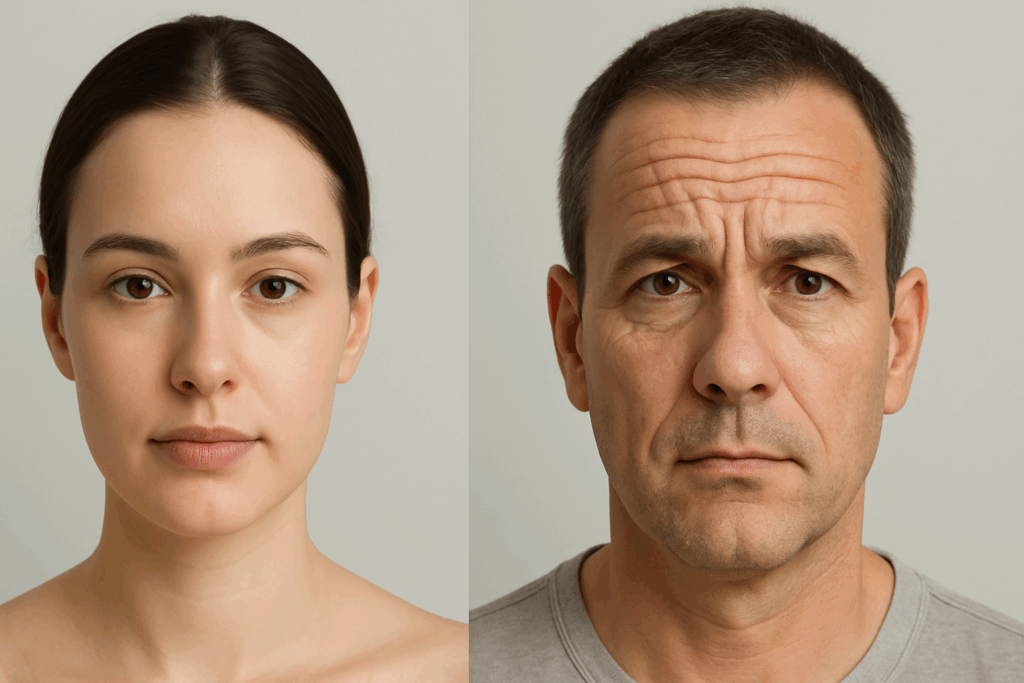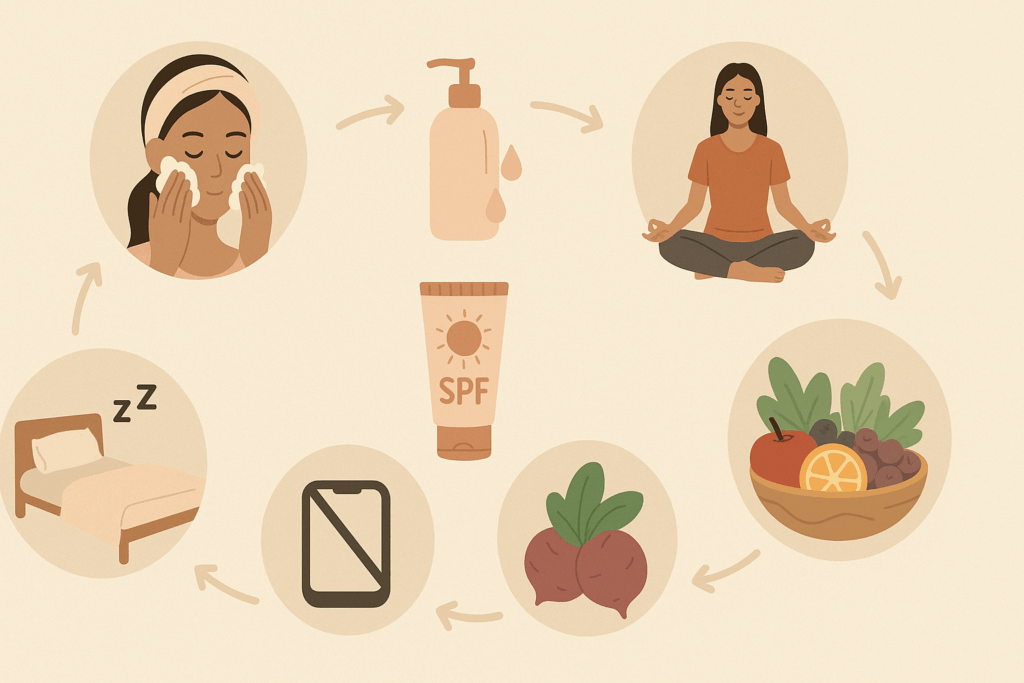The appearance of forehead wrinkles at the age of 16 can be unsettling, especially when these lines are often associated with much older adults. If you find yourself wondering, “Why do I have forehead wrinkles at 16?” or perhaps even “Why do I have wrinkles on my forehead at 15?” you’re not alone. These concerns are increasingly common among adolescents and young adults in today’s high-stress, high-exposure world. Despite popular belief, wrinkles aren’t exclusively a feature of aging; rather, they can be influenced by a variety of internal and external factors even in the teenage years. Understanding these underlying causes not only helps demystify the early signs of skin aging but also empowers you with knowledge to take control of your skin health.
You may also like: How to Choose Skin Care for Fine Lines: Evidence-Based Tips for Healthier, Younger-Looking Skin

The Science Behind Forehead Wrinkles: It’s More Than Just Aging
When people first notice lines forming across the forehead, they often assume it’s a direct sign of aging. However, wrinkles at 18 or even at 14 can occur without any of the usual hallmarks of aging skin. One of the most overlooked contributors is repetitive muscle movement. The frontalis muscle, which raises your eyebrows and expresses emotions such as surprise or concern, plays a direct role in forming these horizontal forehead lines. For teens who are expressive or frequently squinting due to screen exposure or vision issues, this muscle contracts repeatedly, causing dynamic wrinkles to develop prematurely.
In addition to muscular activity, genetics often set the stage for early wrinkle formation. If your parents or grandparents developed facial lines at a younger age, you may be genetically predisposed to follow a similar path. Collagen and elastin, proteins responsible for keeping skin firm and elastic, also vary genetically in their quantity and resilience. Environmental and lifestyle factors, however, determine how quickly these inherited traits manifest as visible signs.
Moreover, stress hormones such as cortisol can accelerate aging processes, including the thinning of the skin and breakdown of collagen. For teenagers dealing with school pressure, social stress, or sleep deprivation, the biological response to chronic stress can mimic that of adults decades older. Therefore, if you’re noticing forehead wrinkles at 16, the interplay between stress and skin health is a key area to consider.

Environmental and Lifestyle Triggers That Speed Up Skin Aging
While genetics lay the foundation, the environment often determines how and when those predispositions become visible. A significant environmental contributor is ultraviolet (UV) radiation from the sun. Teens may not realize that even incidental exposure—like walking to school or sitting near a sunny window—accumulates over time, breaking down skin collagen and resulting in fine lines and wrinkles. It’s no surprise then that some young individuals are left asking, “Why do I have forehead wrinkles at 18?” without ever having spent much time sunbathing.
Screen time and artificial blue light exposure are also emerging as culprits. Though the long-term dermatological consequences of digital devices are still being studied, some research suggests that high-energy visible (HEV) light may penetrate deeper into the skin than UVB rays, potentially contributing to oxidative stress and premature aging. Moreover, squinting at screens or using improper lighting can prompt facial muscle contractions that form and deepen wrinkles over time.
Sleep, or the lack thereof, plays an equally vital role. The skin uses nighttime to repair itself, and sleep deprivation disrupts this natural regeneration cycle. Poor sleep quality has been associated with lower skin barrier function and reduced collagen production, exacerbating fine lines. Lifestyle factors such as smoking, alcohol consumption, and poor dietary choices rich in sugars and processed foods can also damage collagen and elastin, contributing to early signs of aging even before adulthood begins.

Psychological Stress and Its Surprising Effects on Teen Skin
The teenage years are rife with psychological transitions, academic challenges, and social pressures, all of which can contribute to chronic stress. Stress doesn’t just weigh heavily on the mind—it also leaves a physical imprint on the skin. The hormonal changes triggered by stress, particularly increases in cortisol, can thin the dermal layer, slow wound healing, and increase inflammation—all of which are conditions that may lead to premature wrinkles.
Teens who are frequently under emotional distress may also adopt certain facial habits, such as frowning, furrowing the brow, or clenching facial muscles, all of which activate the very muscles responsible for forming wrinkles. This ongoing muscle tension, especially in the forehead, can create static lines that remain even when the face is at rest. These patterns often go unnoticed until the lines become visible, prompting questions like, “Why do I have forehead wrinkles at 14?” or *”What causes forehead wrinkles even in teens?”
Moreover, mental health challenges such as anxiety and depression have been correlated with higher systemic inflammation levels, which in turn can impact skin health. Elevated inflammation speeds up cellular damage, weakens the skin barrier, and depletes vital nutrients, creating a perfect storm for early wrinkle formation. Addressing mental well-being, therefore, is not only vital for psychological health but also for maintaining youthful, resilient skin.

Skin Care Habits That Contribute to Premature Forehead Wrinkles
While intrinsic factors like genetics and stress are significant, skin care habits—both good and bad—play a crucial role in determining whether you develop forehead wrinkles in your teens. Ironically, many over-the-counter products targeted at young people contain harsh ingredients such as alcohols, synthetic fragrances, and exfoliating agents that can strip the skin of its natural oils and compromise the skin barrier. Over-cleansing and using abrasive scrubs can lead to microtears, increased sensitivity, and inflammation—all of which contribute to collagen breakdown over time.
Inconsistency in skincare routines is another common issue among teens. Skipping sunscreen, not moisturizing adequately, or frequently changing products can leave the skin vulnerable to both environmental stressors and internal imbalances. Even the absence of basic protective practices—like wearing SPF daily—can fast-track the development of lines and wrinkles, especially on sun-exposed areas like the forehead.
Social media and beauty influencers also complicate the narrative. The desire to follow trends or use “anti-aging” products without understanding their appropriate use can backfire. For instance, applying retinol-based products without proper moisturizing or sun protection can irritate the skin and accelerate signs of aging instead of preventing them. These practices often lead to questions such as, “Why do I have forehead wrinkles at 18 when I’m using anti-aging products already?” The answer often lies in misuse or misunderstanding of the products involved.
Understanding Muscle Movement: Which Muscles Cause Wrinkles in the Forehead?
To truly understand what causes forehead wrinkles, especially in young people, it’s essential to look at the biomechanics of facial expressions. The primary muscle responsible for horizontal forehead wrinkles is the frontalis. This muscle lifts the eyebrows and is heavily involved in facial communication. Even subtle, repeated movements over time—such as raising eyebrows during conversation or while concentrating—can etch lines into the skin, particularly if the skin lacks elasticity due to environmental or lifestyle-related degradation.
Adjacent muscles such as the corrugator supercilii and procerus also contribute to frown lines, which are vertical wrinkles between the eyebrows. These can accompany or deepen the appearance of horizontal forehead lines. When we consider which muscles cause wrinkles in the forehead, it becomes clear that habitual expressions driven by emotion, concentration, or even light sensitivity can all contribute to early wrinkle development.
It’s also worth noting that the skin’s capacity to return to its original state after muscle contraction is what keeps lines from forming. However, when the skin loses collagen, hydration, and elasticity—whether due to stress, diet, or sun damage—it struggles to bounce back, and the impressions become more permanent. This understanding shifts the focus from merely treating wrinkles to preventing them through proactive skin and health management.

Why Do Some People Lack Forehead Wrinkles, Even in Adulthood?
A puzzling phenomenon that adds to teenage anxiety is the fact that some adults seem to have smooth, wrinkle-free foreheads well into their 30s or even 40s. This often leads teens to question, “Why do some people lack forehead wrinkles, while I have them at 16?” The answer lies in a combination of genetics, lifestyle, and consistent skincare. People who naturally have thicker skin, slower facial movements, or higher collagen production due to their genetic profile may not form wrinkles easily.
Environmental exposure also plays a substantial role. Individuals who have lived in sun-protected environments, practiced lifelong sun safety, and avoided behaviors that accelerate skin aging—such as smoking or poor sleep—are less likely to show visible wrinkles. Some may also have benefited from early and consistent use of moisturizers, antioxidants, and sun protection that preserve skin integrity over decades.
Hormonal balance can further impact skin resilience. For example, estrogen supports skin thickness and hydration, and its gradual decline can affect wrinkle formation. Teenagers experiencing hormonal imbalances, whether due to puberty, birth control, or underlying conditions, may find themselves more prone to skin issues, including wrinkles. This highlights the importance of looking beyond the surface and understanding that everyone’s skin journey is deeply individual.

What Can You Do About Forehead Wrinkles at 16?
If you’ve asked yourself, “Why do I have forehead wrinkles at 16, and what can I do about it?” the good news is that early intervention is both possible and effective. The first step is adopting a consistent, gentle skincare routine tailored to your skin type. A mild cleanser, hydrating moisturizer, and broad-spectrum sunscreen are non-negotiable pillars of any youth-friendly regimen. Adding antioxidants such as vitamin C can further help neutralize free radicals and protect collagen.
Facial awareness is equally important. Learning to be conscious of repetitive expressions or muscle tension in the forehead can help minimize involuntary contractions that lead to wrinkle formation. Simple practices such as taking breaks from screens, practicing good posture, and using blue light filters can also reduce eye strain and associated squinting or furrowing.
Stress management is another powerful tool. Incorporating mindfulness practices such as meditation, yoga, or journaling into your routine can lower cortisol levels and reduce systemic inflammation. Not only does this benefit mental health, but it also promotes overall skin health by improving circulation and enhancing the body’s natural repair mechanisms.
Lastly, consulting a dermatologist is a wise step if you’re concerned about early wrinkles. A professional can assess your skin’s condition, rule out underlying health issues, and recommend safe, age-appropriate treatments. These may include peptide-based serums, hydration boosters, or in some cases, low-dose retinoids used under medical supervision.
Wrinkles at 18 and Beyond: A Broader Perspective on Skin Health
Seeing forehead wrinkles at 18 can feel disheartening, particularly when peers seem unaffected. But rather than viewing these lines as a flaw, consider them a signal from your body. They may be early indicators of stress, environmental exposure, or skincare habits that need adjustment. Addressing these concerns holistically allows you to not only reduce the appearance of wrinkles but also build healthier, more resilient skin over time.
It’s essential to move away from fear-based narratives about aging and instead focus on skin as a living, dynamic organ that reflects your overall well-being. Wrinkles do not signify failure, but they do offer a unique opportunity to learn about your body’s needs. Instead of asking why do I have wrinkles on my forehead at 15, consider asking what your current lifestyle, habits, and emotions might be revealing about your skin’s condition.
Long-term solutions require a blend of science and self-awareness. Whether it’s protecting your skin barrier, nourishing your body with balanced nutrition, or cultivating emotional well-being, the tools for youthful skin extend far beyond topical products. With the right approach, it’s possible to not only reduce current wrinkles but also prevent new ones from forming in the years to come.
Frequently Asked Questions: Understanding Forehead Wrinkles in Teens
1. Why do I have forehead wrinkles at 16 if I’ve never had skin problems before?
Even if your skin has been mostly clear in the past, forehead wrinkles at 16 can still appear due to cumulative lifestyle habits that impact skin elasticity. Expressions such as eyebrow raising, frowning, or squinting contribute to repeated muscular contractions that slowly etch lines into the forehead over time. Additionally, if you’ve recently experienced sleep disruption, increased screen exposure, or even nutritional deficiencies, your skin’s ability to repair and regenerate may have been compromised. These subtle but chronic factors can lead to the appearance of wrinkles even without prior skin issues. Teenagers may find themselves surprised by such changes, asking, “Why do I have forehead wrinkles at 16 when I’ve never struggled with acne or dryness?”—but smooth skin isn’t always a sign of resilience against wrinkle formation.
2. What causes forehead wrinkles to appear more prominently during puberty?
Hormonal fluctuations during puberty significantly impact the skin’s oil production, water retention, and inflammatory response. These hormonal changes, combined with increased stress and self-consciousness, may contribute to repetitive facial expressions like frowning or eyebrow lifting. Over time, this facial tension—especially during emotionally intense adolescent years—can deepen forehead lines. Furthermore, growth spurts can lead to temporarily imbalanced nutrient distribution, affecting skin regeneration and collagen health. As a result, teens may start noticing subtle wrinkles and begin wondering, *”What causes forehead wrinkles when I’m only a teenager?”
3. Why do some people lack forehead wrinkles completely, even as adults?
Some individuals never develop noticeable forehead lines even well into their 40s, prompting questions like “Why do some people lack forehead wrinkles entirely while I have them at 16?” This contrast is often explained by a combination of skin thickness, facial expression habits, and lifelong sun protection. Those who naturally produce more collagen or who engage in minimal facial movement may not form deep lines, even as they age. Others benefit from protective behaviors like consistent sunscreen use, healthy diets rich in antioxidants, and limited sun exposure, which collectively slow down visible aging. Additionally, people with specific ethnic backgrounds or higher melanin levels often possess greater skin density, which can delay wrinkle development.
4. Can early wrinkles indicate a nutritional deficiency or internal health imbalance?
Yes, early signs of forehead wrinkles—whether they occur at 15, 16, or 18—can sometimes be associated with underlying nutritional gaps. Deficiencies in essential nutrients like vitamin C, zinc, and omega-3 fatty acids impair collagen production and skin barrier function. Additionally, chronic dehydration and high-glycemic diets can lead to glycation, a process that stiffens collagen fibers and reduces skin elasticity. Teens who wonder, “Why do I have wrinkles on my forehead at 15 despite using skin care products?” may benefit from assessing dietary intake. In some cases, deeper investigation into gut health or hormonal imbalances can also reveal systemic issues that manifest through premature skin aging.
5. Which muscles cause wrinkles in the forehead, and can their activity be reduced?
The frontalis muscle is the primary mover responsible for raising the eyebrows and creating horizontal lines across the forehead. Over time, habitual contraction of this muscle leads to fixed expression lines. Supporting muscles like the corrugator supercilii and procerus also play a role in forming vertical frown lines between the brows. Teenagers who frequently squint or furrow their brows while reading, using screens, or experiencing emotional tension often ask, “Which muscles cause wrinkles in the forehead, and can I train them to relax?” Techniques such as facial yoga, biofeedback, and awareness-based posture correction can help reduce unconscious muscle tension and potentially soften the onset of wrinkles.
6. Why do I have forehead wrinkles at 14 when my skin is still producing oil?
Oily skin is not a guaranteed protection against wrinkle development. In fact, teens with oily skin often focus heavily on products that strip the skin of natural oils, leading to inflammation and barrier dysfunction. If you’re asking, “Why do I have forehead wrinkles at 14 if my skin is greasy?” it’s worth considering whether aggressive skincare products or stress-related expressions are contributing factors. Furthermore, oily skin doesn’t necessarily equate to healthy collagen levels or optimal hydration. Hydration occurs in deeper layers of the skin and isn’t reflected by surface oiliness alone.
7. How can teens prevent wrinkles at 18 and beyond without using anti-aging products?
The idea that wrinkle prevention requires complex anti-aging products is a misconception, particularly for teens. Many of the most effective habits for preventing wrinkles at 18 involve simple, sustainable practices such as wearing daily SPF, minimizing squinting with proper lighting, getting quality sleep, and eating a nutrient-rich diet. Those asking, “How can I prevent wrinkles at 18 without expensive serums?” should focus on consistency and protection rather than harsh interventions. Even stress management and regular hydration can make a substantial difference in preserving youthful skin. Avoiding trends like excessive exfoliation or overuse of actives can also help maintain a balanced skin barrier well into adulthood.
8. Why do I have forehead wrinkles at 18 when I’m not even in college yet?
Stress does not wait for adulthood to affect skin—and the pressures of high school, social media, and future planning often weigh heavily on teens. Asking “Why do I have forehead wrinkles at 18 if I haven’t started working full-time or studying late?” reflects a broader misunderstanding of how stress manifests physiologically. Even emotional stressors, such as peer pressure or fear of failure, can elevate cortisol levels that weaken skin resilience. Moreover, teens in this age group often adopt high-screen-time habits, inconsistent sleep schedules, and erratic diets—all of which can prematurely impact collagen health and skin elasticity.
9. Is it normal to notice wrinkles on the forehead at 15 even with a clean lifestyle?
Even teens who eat well, avoid sunburns, and maintain a consistent skincare routine may find themselves asking, “Why do I have wrinkles on my forehead at 15 despite doing everything right?” This scenario highlights the complexity of skin biology. Genetics, bone structure, and even the frequency of expressive facial gestures contribute to wrinkle formation in ways that aren’t always within our control. Furthermore, sleep posture—such as resting the face against a pillow—can also lead to the formation of fine lines in areas where the skin is most mobile. These lines may initially fade during the day but deepen over time if unaddressed.
10. What psychological impact can forehead wrinkles at 16 have on teens, and how should they handle it?
For many teens, the appearance of early forehead wrinkles can trigger self-esteem issues, especially in a social climate heavily influenced by filtered images and curated perfection. Teens asking, “Why do I have forehead wrinkles at 16 when my friends don’t?” may internalize the issue as a flaw, potentially leading to body dysmorphia or social withdrawal. However, it’s crucial to recognize that these lines often reflect emotional expressiveness and active engagement with the world—not weakness or decline. Mental health professionals recommend cultivating body neutrality and focusing on the skin’s functional health rather than just its appearance. Open conversations with trusted adults, therapists, or dermatologists can help teens reframe these concerns and avoid falling into cycles of self-criticism.
Final Thoughts: Understanding Early Wrinkles and Embracing Preventive Skin Wisdom
If you’re navigating the emotional and physical complexities of forehead wrinkles at 16, you are not alone—and you are certainly not powerless. From understanding which muscles cause wrinkles in the forehead to uncovering why some people lack forehead wrinkles entirely, this journey reveals that skin health is as much about internal balance as it is about external care. The question, “Why do I have forehead wrinkles at 16?” is not a reflection of defect but a prompt to explore your skin’s unique story, which includes genetic cues, environmental influences, emotional patterns, and lifestyle choices.
By addressing the root causes—ranging from stress and muscle movement to sun exposure and product misuse—you can take proactive steps toward smoother, healthier skin. Even if you’ve already noticed forehead wrinkles at 14 or wrinkles at 18, the body is remarkably responsive to care, especially when that care is rooted in knowledge, consistency, and compassion.
Ultimately, embracing a long-term mindset of prevention and self-care, rather than panic or perfectionism, lays the foundation for skin that not only looks better but functions optimally. And in doing so, you gain more than wrinkle-free skin—you gain a deeper understanding of your body, your health, and your power to influence both.
Was this article helpful? Don’t let it stop with you. Share it right now with someone who needs to see it—whether it’s a friend, a colleague, or your whole network. And if staying ahead on this topic matters to you, subscribe to this publication for the most up-to-date information. You’ll get the latest insights delivered straight to you—no searching, no missing out
Further Reading:
Wrinkles & Fine Lines: Types, Causes & Prevention
How to Get Rid of Forehead Wrinkles, According to Dermatologists
Everything You Need to Know About Premature Aging
Disclaimer
The information contained in this article is provided for general informational purposes only and is not intended to serve as medical, legal, or professional advice. While Health11News strives to present accurate, up-to-date, and reliable content, no warranty or guarantee, expressed or implied, is made regarding the completeness, accuracy, or adequacy of the information provided. Readers are strongly advised to seek the guidance of a qualified healthcare provider or other relevant professionals before acting on any information contained in this article. Health11News, its authors, editors, and contributors expressly disclaim any liability for any damages, losses, or consequences arising directly or indirectly from the use, interpretation, or reliance on any information presented herein. The views and opinions expressed in this article are those of the author(s) and do not necessarily reflect the official policies or positions of Health11News.